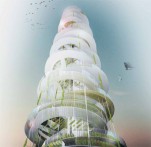The Innovative Architecture

Founded in Barcelona in 2010, JAPA – Javier Ponce Architects – aims to implement architecture projects, visions and develop consistent strategies and critical solutions which can impact in a positive way at both local and global levels. The architects are interested in different scales and sorts of projects, ranging from small objects to city masterplans and with diverse constraints, which they transform into opportunities.
The main focus of their architectural practice is FORWARD THINKING ARCHITECTURE, which is defined as: thinking about, planning for, or considering the future, rather than just the present.
FORWARD THINKING ARCHITECTURE is the counterpart and research arm of their architectural practice. It is based on an ideas LAB format, involved on a variety of subjects such as architecture, urbanism, prototype development and strategic Thinking and its effects on the city.
The architects are immersed in a changing world, where new ideas, surprises and unexpected juxtapositions are emerging in a daily basis. They live and work in the present, dealing with real projects and current affairs according to existing contexts, but also have a proactive mentality and always try to anticipate future needs adding efforts to multiply results. They are aimed to develop potential strategies and new ways of Thinking (T) that can improve the quality of life. They have already started exploring and developing Forward Thinking Initiatives operating in different areas that can combine multiple disciplines.
The studio is currently engaged in the further study of subjects such as:
– Self-Sufficiency
– Adaptive reuse
– Territorial Farming Networks
– Multi-programmatic approach / Multifunctionality
– Public space interaction
– Social upgrading-Housing-Slums
– Technology and Smart Cities among others
Dyv-net
The idea of the Dyv-net project was inspirited by the desire of strategic rethink of the Asian City: China’s limited space for farming and food mileage reduction. “Since Hong Kong has a predominant verticality, a lack of buildable space and consist largely of steep hillside, it could be interesting to reinterpret this verticality and propose this new type of vertical farming on the city’s outskirts “ Javier F. Ponce, Dyvnet architect.
Since 2000, China’s cities have expanded at an average rate of 10% annually. Although China’s agricultural output is the largest in the world, only about 15% of its total land area can be cultivated. China’s arable land, which represents 10% of the total arable land in the world, supports over 20% of the world’s population. Of this approximately 1.4 million square kilometers of arable land, only about 1.2% (116,580 square kilometers) permanently supports crops and 525,800 square kilometers are irrigated. The land is divided into approximately 200 million households, with an average land allocation of just 0.65 hectares (1.6 acres).
Full content of this issue you can read here
The full version of the article can be read in our printed issue, also you can subscribe to the web-version of the magazine
 Materia ls provided by JAPA
Materia ls provided by JAPA


